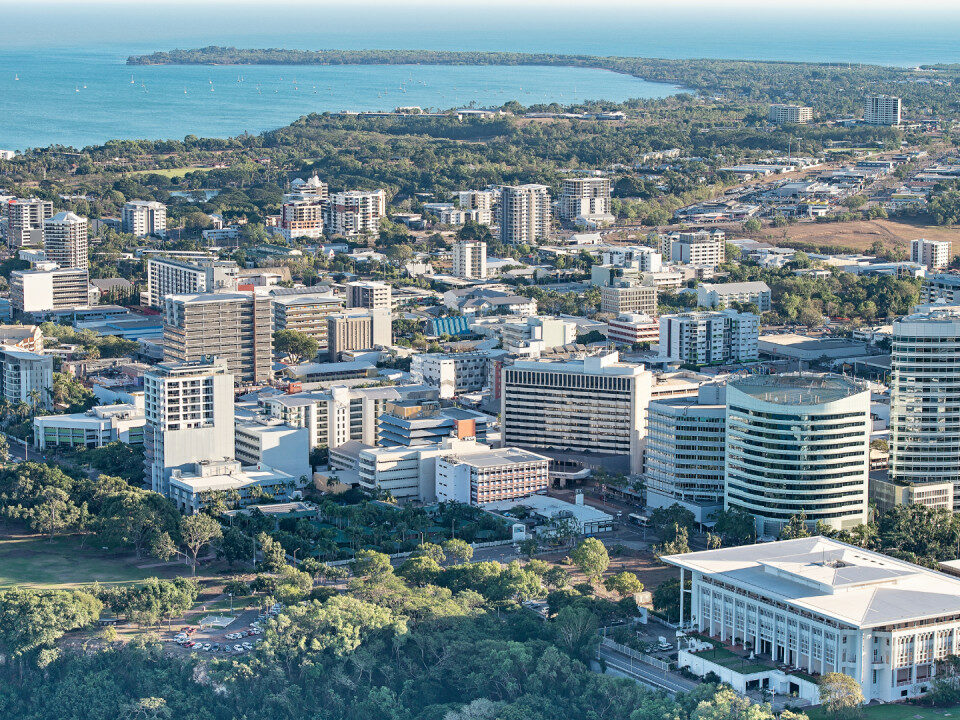- The first step is making the call.
- 1300 022 482
- hello@searchpartyproperty.com.au
31st May 2023 – Property Market Update
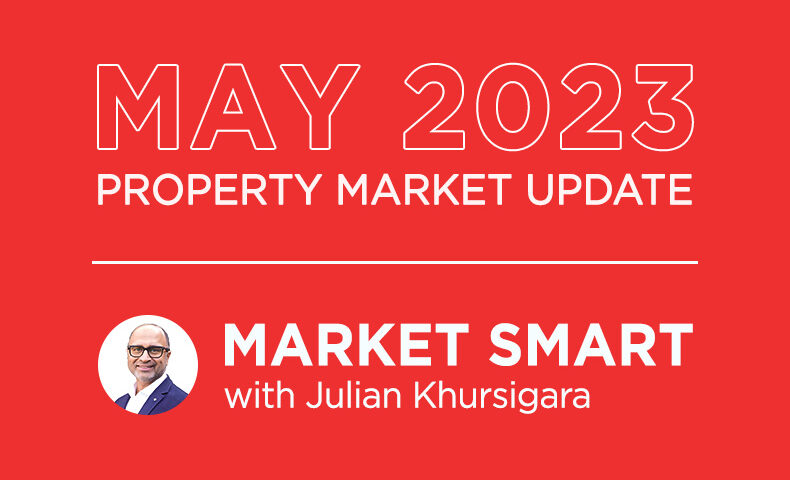
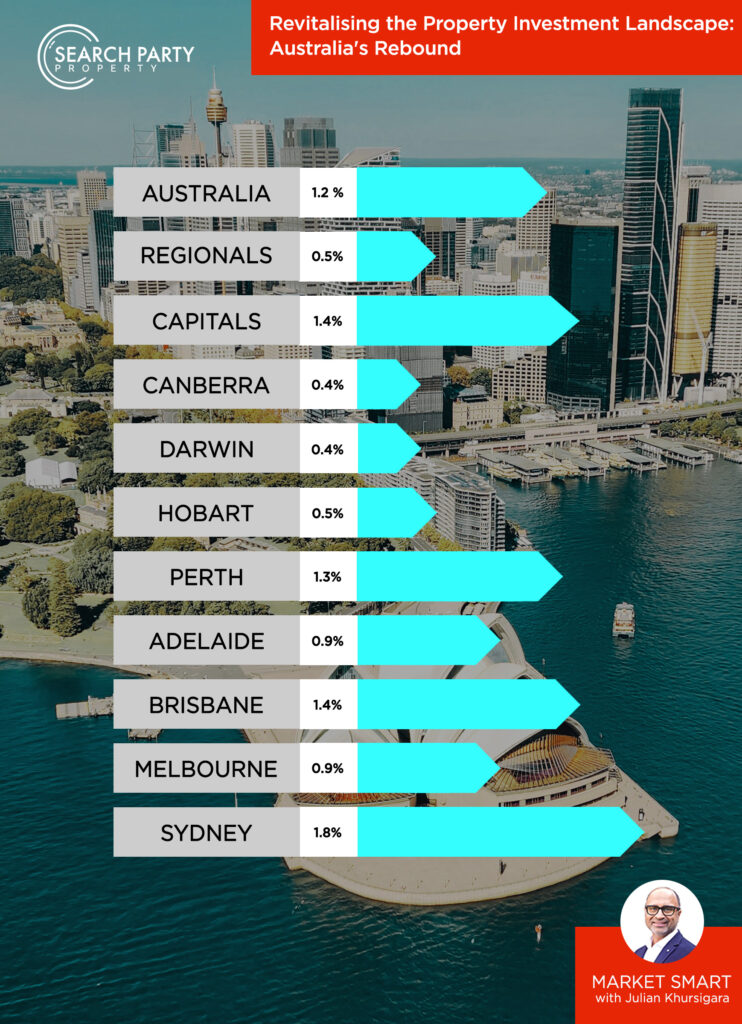
The Australian property market has continued its strong April performance into May, with an accelerating rate of aggregate value increases across the nation, despite rising interest rates.
Wondering what’s driving this rebound, and its ramifications for the future? Stick with us as we delve into the interconnected factors at play and discuss potential implications for Australian homeowners and investors.
Where we are now?

Source: CoreLogic, 2023
- National aggregate home values rose 1.2% in May, a significant uptick over April’s 0.5% growth.
- All capital cities have recorded growth for the first time in some months.
- The rate of growth has increased across all capital cities.
- Brisbane has demonstrated the largest increase (up to 1.4% from 0.3%), with Melbourne (up to 0.9% from 0.1%) in second place. Perth and Adelaide lie close behind in equal third, with 0.7% month on month growth.
- Darwin has at last recorded growth, up to a 0.4% increase following April’s -1.2% decrease.
- Hobart and Canberra have risen to 0.5% and 0.4% growth respectively, emerging from no change in April.
- Across the preceding 12 months, the deficit in has fallen to -6.8% in aggregate, down from -8.0%.
How did we get here?
Yet again, price growth persists in the face of ongoing interest rate rises.
We observed a similar pattern in April, where this puzzling situation was credited to “a worsening disparity between supply and demand” – apparently outweighing the contractionary effects of earlier rate hikes.
A continuing combination of factors are responsible for these latest figures.
Two persistent trends among supply data are:
- Exceptionally low levels of market supply:
- New Listings:
- New listings are 26% lower than they were at this time last year, and 13.1% below 5-year averages.
- Since March 2023, new listings volume has been in steady decline but now showing signs of plateauing.
- Total Listings
- Total listings are 15.3% lower than they were at this time last year, and 24.4% below 5-year averages.
- The decline in total listings that began in March remains steady, an indication that buyer demand continues to outpace the flow of new listings onto the market.
- New Listings:
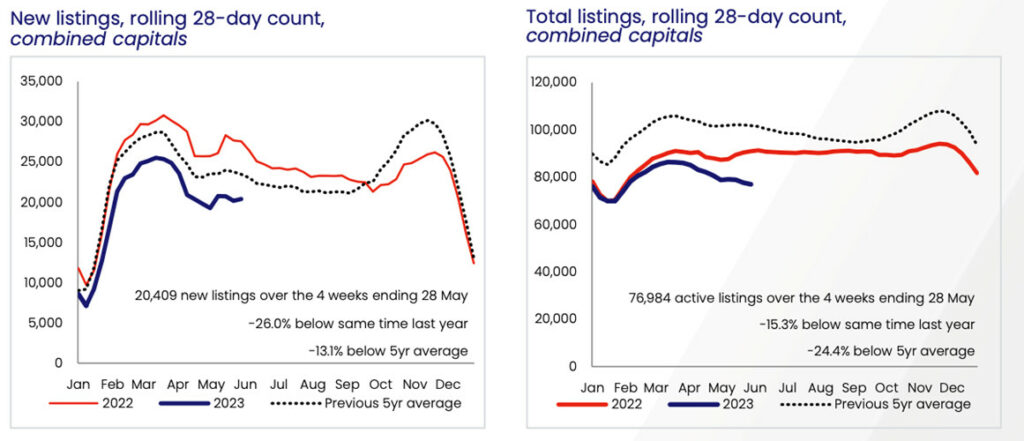
- Extremely low vacancy rates:
- Aggregate vacancy rates are holding relatively steady at 1% (below), indicating high demand and a lack of a commensurate supply response.
- Capital city rental listings are -36.4% below 5-year averages.
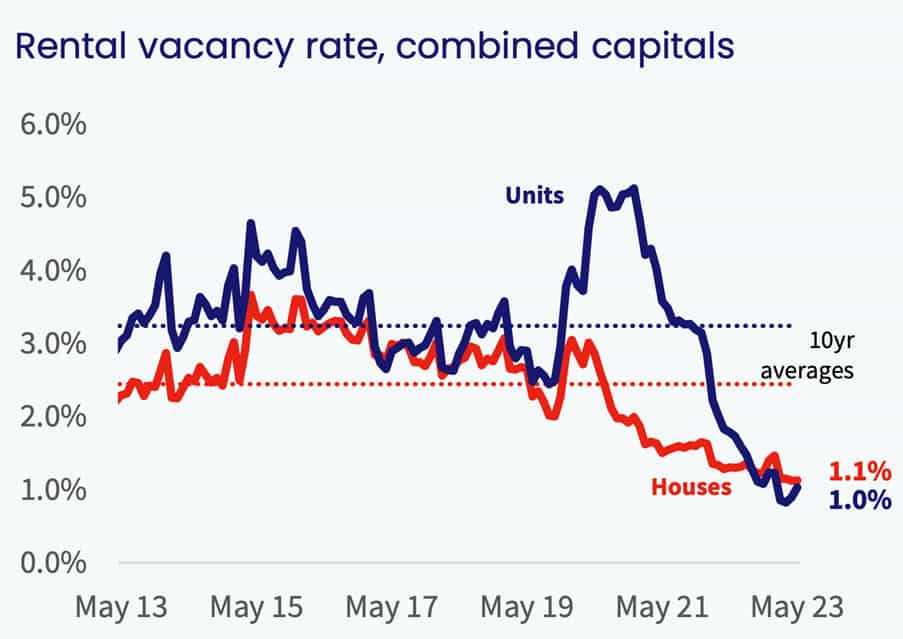
Why is supply so low?
It’s difficult to pin down exactly why supply remains low, when we might otherwise expect property owners to want to cash in on rising values. Like most things, several factors may be at play:
- Reluctance to sell:
It could be that investors and homeowners are reluctant to sell immediately if they expect prices to continue rising. This kind of speculation en masse can become a self-fulfilling prophesy, where low market supply creates the very price growth that property owners were holding out for.
- Consumer Confidence:
The latest ANZ-Roy Morgan Consumer Confidence report indicated a fall in sentiment of 1.8 pts, down to 75.9 – making this the longest running stretch of a sub-80 consumer confidence, since the weekly index began recording back in 2008 (Roy Morgan, 2023).
- Market cycles:
It is historically true that sales volumes decline across the winter months, and the ongoing decline is consistent with that timing (albeit to a larger extent).
Will the growth continue?
On the balance of the data currently available, it seems likely this growth will persist for some time. There is no obvious trend towards or indication of an imminent supply increase. Moreover, the latest financing data suggests increasing levels of investor participation (with a 30% jump in loan approvals across Q1 of this year), keeping demand high.
However, here are few things to look out for:
- Mortgage Stress
This week’s latest rate hike and a sharp rise in fixed rate loans coming to term over the next few months will fuel levels of mortgage stress. However, tight labour markets and healthy levels of household savings may combine to mitigate this and keep distressed sales to a minimum.
This will be an interesting balancing act, depending heavily on the RBA’s actions in the latter half of the year. In accordance with traditional economic theory, inflation and unemployment are broadly characterised by an inversely proportional relationship, defined by the Philips Curve:
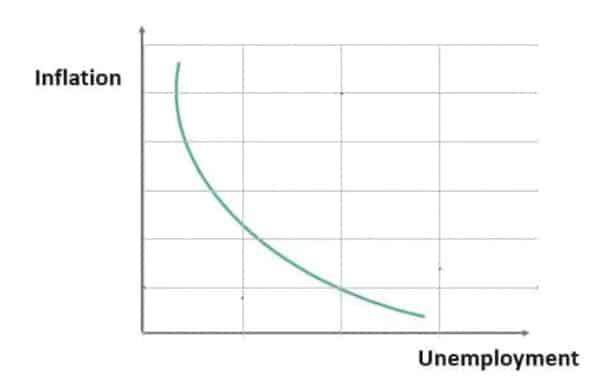
Thus in theory, further contractionary monetary policy measures from the RBA to halt inflation may consequently increase unemployment – inadvertently worsening the effects of mortgage stress.
- Inflation and a Wealth Effect
Moreover, as we expect inflation to continue to trend toward the RBA’s target range, one interesting phenomenon that may come into play is the wealth effect.
Related to notions of consumer confidence and sentiment, the wealth effect refers to the idea that individuals’ spending and consumption patterns are dictated by changes in their perceived wealth.
Where this may become a risk factor for inflation, is if rising housing prices create a wealth effect, improving sentiment and raising consumption levels. The Reserve Bank acknowledges the importance of considering rising asset prices in relation to inflation, although this falls outside of their mandate.
Notably, cash rate futures and FX markets have readjusted following the RBA’s rate hike, reflecting increasing expectations that further rises will yet occur.
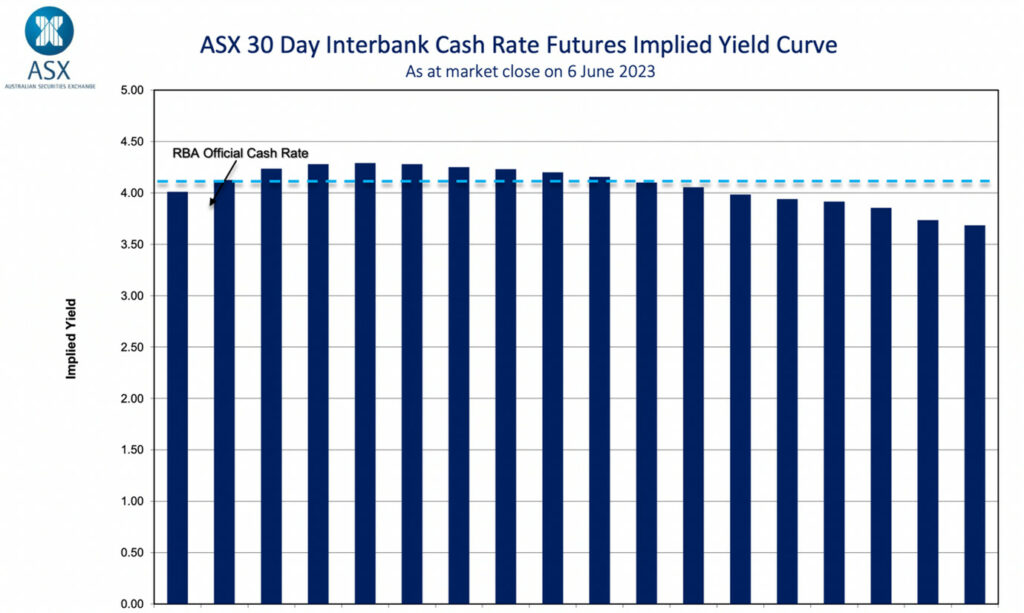
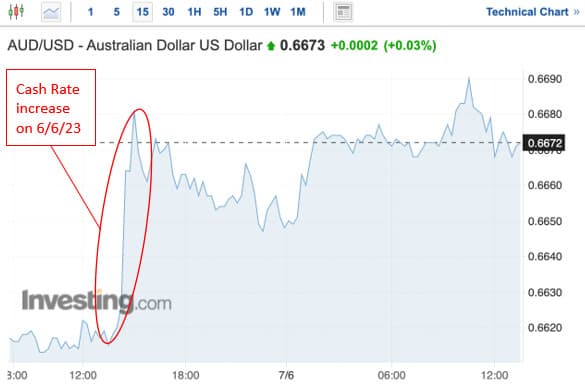
Despite the potential challenges and uncertainty ahead, it’s clear that the Australian property market is well and truly on the road to recovery. Here at Search Party Property, we are well-equipped to help clients navigate this changing landscape and make data-driven, informed decisions about their property purchases. If you’re looking to enter the property market, get in touch with us today to discuss how we can help you achieve your goals.
Suburb Spotlight – Lynwood
In this month’s Market Smart, we’ve chosen Lynwood, WA as our spotlight suburb, to highlight its exceptional investment potential. Lynwood’s median house price stands at just $460,000, while the median rent comes in at $500.
The suburb boasts a diverse age demographic, a growing population and healthy rental demand. Lynwood’s combination of growth and stability make it an ideal candidate for further exploration. Get in touch today to secure your next investment property in this flourishing suburb!
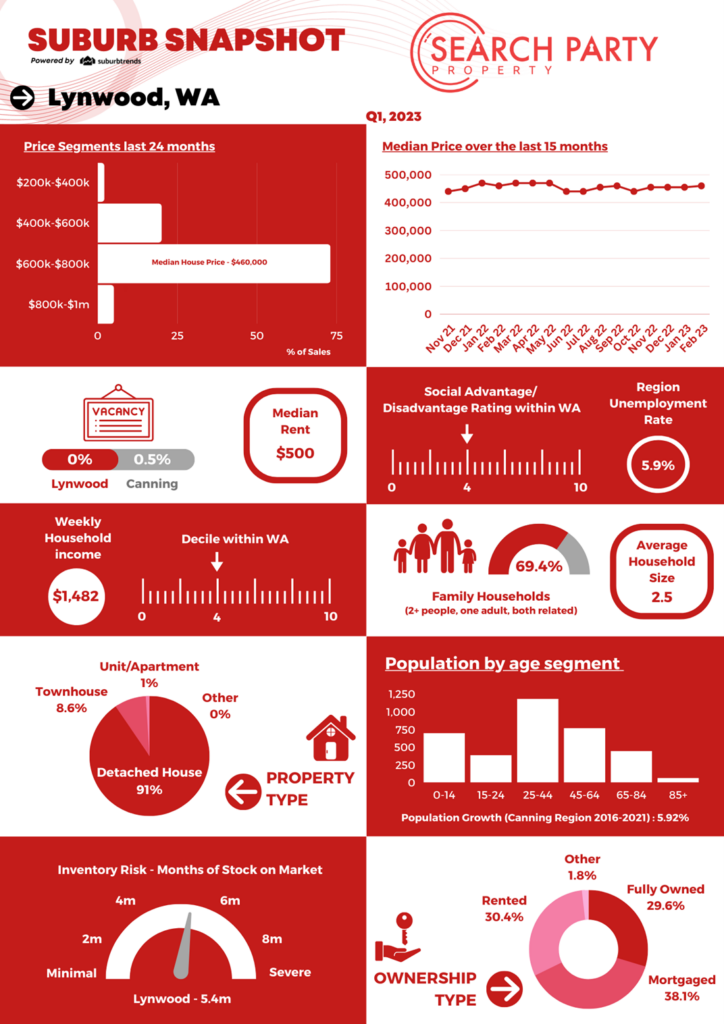
At Search Party Property, we specialise in developing tailored investment strategies and will work with you to come up with a suitable plan of attack. We also regularly assess your strategy ensuring that it is fit for purpose and delivering the desired results.



